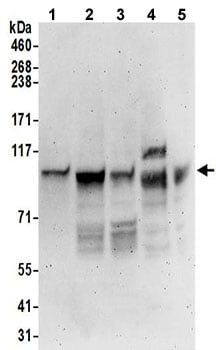Anti-ORP-3 antibody (ab192998)
Key features and details
- Rabbit polyclonal to ORP-3
- Suitable for: WB, IP
- Reacts with: Mouse, Human
- Isotype: IgG
Overview
-
Product name
Anti-ORP-3 antibody
See all ORP-3 primary antibodies -
Description
Rabbit polyclonal to ORP-3 -
Host species
Rabbit -
Tested Applications & Species
See all applications and species dataApplication Species IP HumanWB MouseHuman -
Immunogen
Synthetic peptide within Human ORP-3 aa 450-550. The exact immunogen sequence used to generate this antibody is proprietary information. If additional detail on the immunogen is needed to determine the suitability of the antibody for your needs, please contact our Scientific Support team to discuss your requirements. (NP_056365.1).
Database link: Q9H4L5 -
Positive control
- HeLa, 293T, Jurkat, TCMK1 and NIH 3T3 whole cell lysates.
-
General notes
Previously labelled as OSBPL3.
Properties
-
Form
Liquid -
Storage instructions
Shipped at 4°C. Store at +4°C short term (1-2 weeks). Upon delivery aliquot. Store at -20°C long term. Avoid freeze / thaw cycle. -
Storage buffer
pH: 7
Preservative: 0.09% Sodium azide
Constituent: 99% Tris citrate/phosphate
pH 7 to 8 -
 Concentration information loading...
Concentration information loading... -
Purity
Immunogen affinity purified -
Purification notes
ab192998 was affinity purified using an epitope specific to ORP-3 immobilized on solid support. -
Clonality
Polyclonal -
Isotype
IgG -
Research areas
Images
-
All lanes : Anti-ORP-3 antibody (ab192998) at 0.1 µg/ml
Lane 1 : HeLa whole cell lysate
Lane 2 : 293T whole cell lysate
Lane 3 : Jurkat whole cell lysate
Lane 4 : TCMK1 whole cell lysate
Lane 5 : NIH 3T3 whole cell lysate
Lysates/proteins at 50 µg per lane.
Developed using the ECL technique.
Predicted band size: 101 kDa
Exposure time: 3 minutesLysates prepared using NETN lysis buffer.
-
Detection of ORP-3 in immunoprecipitates of 293T whole cell lysate (prepared using NETN lysis buffer; 1 mg for IP, 20% of IP loaded) using ab192998 at 6 µg/mg lysate for IP and at 1 µg/ml for subsequent Western blot detection (lane 1). Lane 2 represents control IgG IP.
Detection: Chemiluminescence with an exposure time of 30 seconds.















